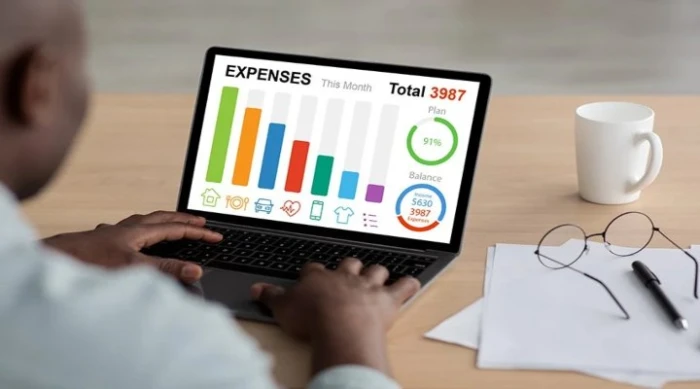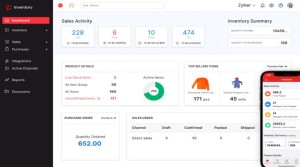Top 10 Ways to Track Your Spendings
It can take a lot of work to keep track of your money, especially with so many things to spend it on.

It can take a lot of work to keep track of your money, especially with so many things to spend it on. Knowing where your money goes is essential for managing your finances. This can help you plan your spending, save for what you want, and avoid debt.
Now, we will explain the top 10 ways to keep track of your spendings; these tips can help you achieve your money goals.
1. Create a Budget
A budget is a plan for your money. It shows how much you'll make and spend in a specific time. When you make a budget, you put your spending into groups - things you always pay for such as rent and things that change like food or fun. This helps you see where your money goes and how much you can spend on different things.
2. Use a Spending Tracker App
In today's digital age, numerous apps can help your track your spending effortlessly. They put your spending into different groups and show you how you spend your money. Popular options include Mint, YNAB (You Need a Budget), and Pocket Guard. These tools simplify tracking and give you a clear view of your financial situation, enabling better decision-making.
3. Maintain a Spending Journal
Maintaining a spending journal can be effective for those who prefer a more hands-on approach. You develop a deeper awareness of your spending habits by manually recording every purchase in a notebook or digital document. This method encourages mindfulness and can reveal patterns you might not notice with automated tools.
4. Review Bank Statements Regularly
It's essential to check your bank and credit card statements often. This helps you see how much you've spent. You can also find out if someone has used your card without your permission or if you're paying for things you don't need. Checking your statements helps you manage your money better.
5. Set Spending Alerts
Many banking institutions offer the option to set up spending alerts. These notifications can inform you when you reach a specific spending threshold, reminding you to stay within your budget. Alerts can also notify you of low account balances or unusual transactions, adding a layer of security to your financial management.
6. Categorize Your Expenses
Breaking down your expenses into categories is vital in understanding your spending patterns. Common categories include housing, transportation, food, entertainment, and savings. By categorizing your expenses, you can see where most of your money goes and identify areas where you can cut back. This understanding helps you make intelligent choices about spending your money and focus on your critical financial goals.
7. Implement the Envelope System
The envelope system is a traditional budgeting method that effectively controls discretionary spending. In this approach, you allocate a specific amount of cash to different spending categories and place that cash in labeled envelopes. Once the money in an envelope is gone, you can only spend more in that category during the next budgeting period. This system encourages discipline and helps prevent overspending.
8. Analyze Spending Trends
Take the time to analyze your spending trends over time. Look for patterns in your monthly expenses to understand your financial behavior better. Are there specific times of the year when you tend to spend more? Are there categories where you consistently overspend? Recognizing these trends allows you to adjust your budget and spending habits accordingly.
9. Establish Financial Goals
If you set specific financial goals, you'll be more motivated to keep track of how much you spend. Instead of saving for a trip, paying off a debt, or building an emergency fund, you could use the money for something else. Having a goal can help you focus on spending your money wisely. As you track your spending, you can evaluate your progress toward these goals, adjusting your budget and habits as needed.
10. Seek Professional Guidance
If tracking your spending feels daunting or you struggle with budgeting, seeking help from a financial advisor can be beneficial. Professionals can provide personalized advice, help you create a budget, and suggest strategies to improve your financial situation. They can also help you find good places to invest your money and plan your financial future.
Tracking your spending is essential for effective financial management and achieving your goals. By implementing the top 10 methods outlined above, you can better understand your financial habits, make informed decisions, and ultimately take control of your finances. Whether you prefer digital tools or traditional methods, finding a system that works for you is vital. With commitment and consistency, you can cultivate better spending habits and set yourself on the path to financial stability and success.
Also, read the other related posts.

It can take a lot of work to keep track of your money, especially with so many things to spend it on. Knowing where your money goes is essential for managing your finances. This can help you plan your spending, save for what you want, and avoid debt.
Now, we will explain the top 10 ways to keep track of your spendings; these tips can help you achieve your money goals.
1. Create a Budget
A budget is a plan for your money. It shows how much you'll make and spend in a specific time. When you make a budget, you put your spending into groups - things you always pay for such as rent and things that change like food or fun. This helps you see where your money goes and how much you can spend on different things.
2. Use a Spending Tracker App
In today's digital age, numerous apps can help your track your spending effortlessly. They put your spending into different groups and show you how you spend your money. Popular options include Mint, YNAB (You Need a Budget), and Pocket Guard. These tools simplify tracking and give you a clear view of your financial situation, enabling better decision-making.
3. Maintain a Spending Journal
Maintaining a spending journal can be effective for those who prefer a more hands-on approach. You develop a deeper awareness of your spending habits by manually recording every purchase in a notebook or digital document. This method encourages mindfulness and can reveal patterns you might not notice with automated tools.
4. Review Bank Statements Regularly
It's essential to check your bank and credit card statements often. This helps you see how much you've spent. You can also find out if someone has used your card without your permission or if you're paying for things you don't need. Checking your statements helps you manage your money better.
5. Set Spending Alerts
Many banking institutions offer the option to set up spending alerts. These notifications can inform you when you reach a specific spending threshold, reminding you to stay within your budget. Alerts can also notify you of low account balances or unusual transactions, adding a layer of security to your financial management.
6. Categorize Your Expenses
Breaking down your expenses into categories is vital in understanding your spending patterns. Common categories include housing, transportation, food, entertainment, and savings. By categorizing your expenses, you can see where most of your money goes and identify areas where you can cut back. This understanding helps you make intelligent choices about spending your money and focus on your critical financial goals.
7. Implement the Envelope System
The envelope system is a traditional budgeting method that effectively controls discretionary spending. In this approach, you allocate a specific amount of cash to different spending categories and place that cash in labeled envelopes. Once the money in an envelope is gone, you can only spend more in that category during the next budgeting period. This system encourages discipline and helps prevent overspending.
8. Analyze Spending Trends
Take the time to analyze your spending trends over time. Look for patterns in your monthly expenses to understand your financial behavior better. Are there specific times of the year when you tend to spend more? Are there categories where you consistently overspend? Recognizing these trends allows you to adjust your budget and spending habits accordingly.
9. Establish Financial Goals
If you set specific financial goals, you'll be more motivated to keep track of how much you spend. Instead of saving for a trip, paying off a debt, or building an emergency fund, you could use the money for something else. Having a goal can help you focus on spending your money wisely. As you track your spending, you can evaluate your progress toward these goals, adjusting your budget and habits as needed.
10. Seek Professional Guidance
If tracking your spending feels daunting or you struggle with budgeting, seeking help from a financial advisor can be beneficial. Professionals can provide personalized advice, help you create a budget, and suggest strategies to improve your financial situation. They can also help you find good places to invest your money and plan your financial future.
Tracking your spending is essential for effective financial management and achieving your goals. By implementing the top 10 methods outlined above, you can better understand your financial habits, make informed decisions, and ultimately take control of your finances. Whether you prefer digital tools or traditional methods, finding a system that works for you is vital. With commitment and consistency, you can cultivate better spending habits and set yourself on the path to financial stability and success.
Also, read the other related posts.
Conversation
Latest Blogs
© Blog CoolCalculator, Explore CoolCalculator, your destination for the latest insights, tips, and updates on the world of online calculators. Stay informed and make your calculations smarter with our blog. ,
Designed
by Saad Media Team , Team Lead M.Rizwan Akhtar












